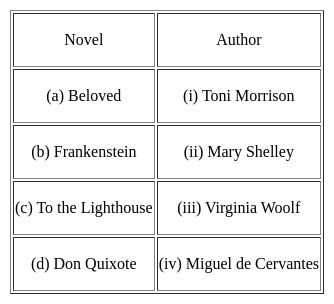MH SET Paper 2 Mock Test - 8 (English) - MAHA TET MCQ
30 Questions MCQ Test MH SET Mock Test Series 2025 - MH SET Paper 2 Mock Test - 8 (English)
Which among the following is not true about Francis Bacon?
Which phrase indicates the interior flow of thought employed in High-modern literature?
A Young Lady's Entrance into the World is the sub-title of ____ .
The roman a clef ( French for " novel with a key ") uses contemporary historical figures as its chief character. They are of course given fictional names. One explain is Aldous Hixley's point Counter Point. Its Mark Rampion is modelled on _____.
Which of the following is another term to describe “art for art’s sake”?
In which year did the Great Exhibition take place?
Given below are two statements one is labelled as Assertion and the other one is labelled as Reason.
Assertion: Francis Bacon's "The Advancement of Learning" marks a significant shift in the Renaissance attitude towards knowledge, advocating for a more empirical and inductive approach.
Reason: Bacon critiques the prevailing methods of scholasticism and emphasizes the importance of observation, experimentation, and systematic inquiry in acquiring knowledge.
Choose the most appropriate option-
Which of the following is NOT mentioned in Northrop Frye's four generic plots '?
Which of the following novels does not belong to Nuruddin Farah’s Blood In the Sun Trilogy?
Directions- Something there is that doesnít love a wall, That sends the frozen-ground-swell under it, And spills the upper boulders in the sun; And makes gaps even two can pass abreast. The work of hunters is another thing: I have come after them and made repair Where they have left not one stone on a stone, But they would have the rabbit out of hiding, To please the yelping dogs. The gaps I mean, No one has seen them made or heard them made, But at spring mending-time we find them there. I let my neighbor know beyond the hill; And on a day we meet to walk the line And set the wall between us once again. We keep the wall between us as we go. To each the boulders that have fallen to each. And some are loaves and some so nearly balls We have to use a spell to make them balance: 'Stay where you are until our backs are turned!' We wear our fingers rough with handling them. Oh, just another kind of outdoor game, One on a side. It comes to little more: There where it is we do not need the wall: He is all pine and I am apple orchard. My apple trees will never get across And eat the cones under his pines, I tell him. He only says, 'Good fences make good neighbors.' Spring is the mischief in me, and I wonder If I could put a notion in his head: 'Why do they make good neighbors? Isn't it Where there are cows? But here there are no cows. Before I built a wall Iíd ask to know What I was walling in or walling out, And to whom I was like to give offense. Something there is that doesnít love a wall, That wants it down.' I could say 'Elves' to him, But itís not elves exactly, and Iíd rather He said it for himself. I see him there Bringing a stone grasped firmly by the top. In each hand, like an old-stone savage armed. He moves in darkness as it seems to me, Not of woods only and the shade of trees. He will not go behind his fatherís saying, And he likes having thought of it so well. He says again, 'Good fences make good neighbors.'
What is the reason for the poet to say 'Something there is that doesn't love a wall' ?
____ is a theological term brought into literary criticism by ____.
Robert Browning’s “Rabbi Ben Ezra” is a defence of
In Thomas More’s Utopiawhich of the following leisure pastimes is not a favourite among Utopians?
Which of the following novels by H. G. Wells is about the condition of England as Empire?
|
60 tests
|
















